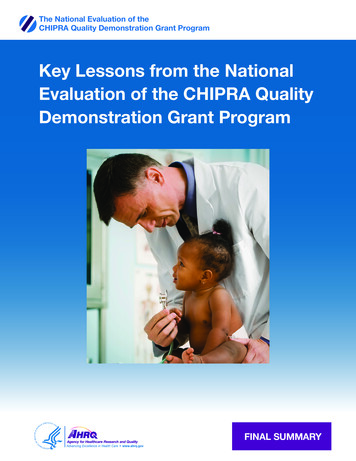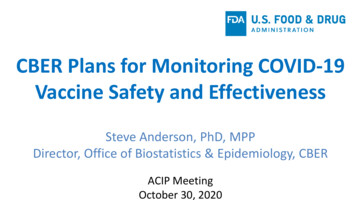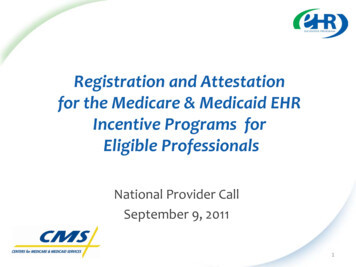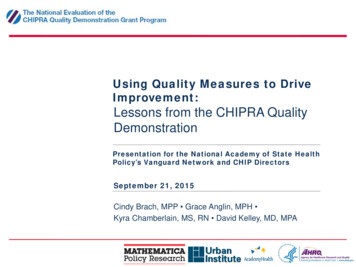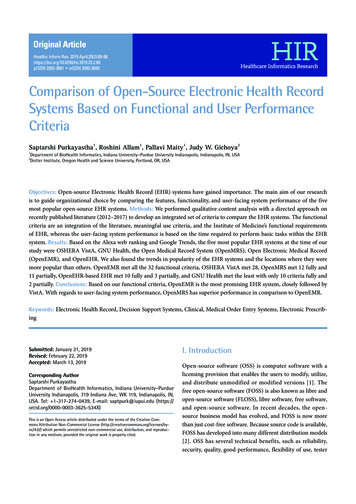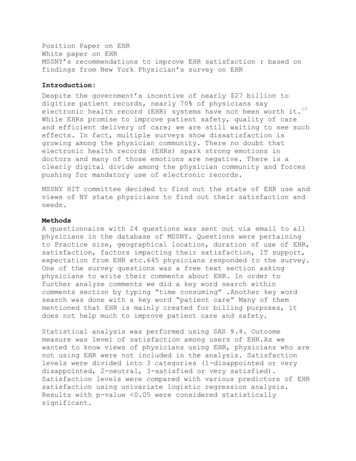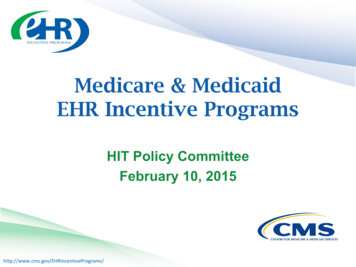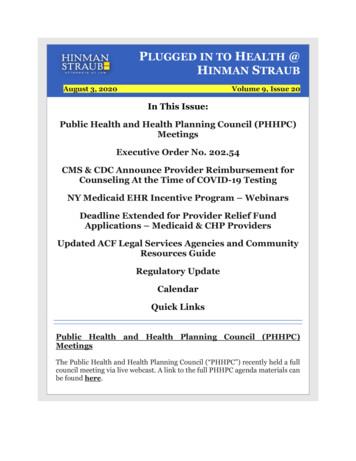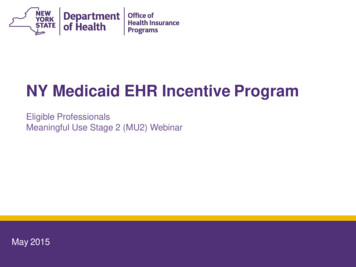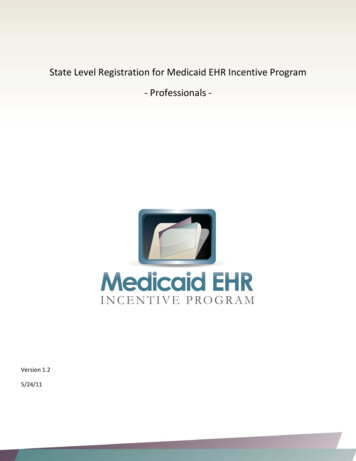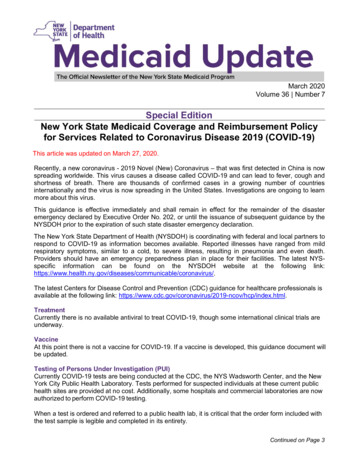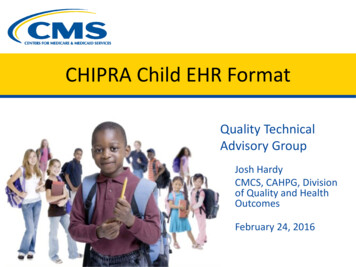
Transcription
CHIPRA Child EHR FormatQuality TechnicalAdvisory GroupJosh HardyCMCS, CAHPG, Divisionof Quality and HealthOutcomesFebruary 24, 2016
Objectives Review Federal efforts to identify pediatricEHR needs Discuss lessons learned from North Carolinaand Pennsylvania’s experiences with testingthe Children’s EHR Format Review Federal efforts to further refine theFormat by identifying a priority list ofpediatric EHR needs2
Background EHR use in the pediatric setting has beenassociated with improved quality of care More than 43 million children enrolled in aMedicaid or CHIP program in FFY2014 2012 American Academy of Pediatrics Survey:only 8% of pediatricians reported using fullyfunctional EHRs Compared to all physicians (2014) – 74%used a fully functional EHR3
Children’s Health Insurance ProgramReauthorization Act of 2009 CHIPRA called for the establishment of a program to encourage thedevelopment and dissemination of a model electronic health recordformat for children enrolled in Medicaid and CHIP. Congress said that this format should be: accessible to parents, caregivers, and other consumers for the solepurpose of demonstrating compliance with school or leisure activityrequirements, such as appropriate immunizations or physicals designed to allow the interoperable exchange of healthinformation structured in a manner that permits parents and caregivers toview and understand the extent to which the care their childrenreceive is clinically appropriate and of high quality capable of being incorporated into, and otherwise compatiblewith, other standards developed for electronic health records4
Initial Format Released in 2013 Contained 547 specific items that a model EHRshould contain Example: The system shall produce reports (e.g.,for camp, school, or child care) of a child'simmunization history, including the followingelements: child's name, date of birth and sex,date the report was produced, antigenadministered, date administered, route ofadministration (when available), and anindication of whether a vaccine was refused orcontraindicated.5
CHIPRA Quality Demonstration Grant 100 million investment to improve care for children in theUnited States by testing and evaluating the use of corequality measures, health information technology, andprovider-based delivery models Two grantees: NC and PA practicing pediatricians, and theirvendors, were asked to review Format items (i.e., EHRneeds) to determine whether their current EHR had thecapability and, if not, determine whether the EHR could bemodified6
North Carolina Partners:– 6 EHR vendors– 26 independent pediatric or family practices Approach:– Hired, trained, and supervised four EHR coaches whoseprofessional backgrounds ranged from nursing to practicemanagement to health IT– CHIPRA quality demonstration staff asked EHR vendors to agreeto (1) complete and return a survey that compared existingproducts to 133 requirements of the Format, (2) train EHRcoaches to use EHR features that practice staff were not familiarwith, and (3) indicate whether their products will meet specificFormat requirements in the foreseeable future.7
North Carolina Accomplishments and Changes Implemented:– Auto-populating of forms: Oral Health Risk Assessment and Referral Kindergarten Health Assessment Risk Stratification Tool– Collection and Reporting of 16 Pediatric eCQMs Lessons Learned– Role of provider relationships and coaching is key factor indriving practice change (e.g., charting workflows)– Practices need HIT human resources to describe to HITvendors what’s important to pediatrics8
Pennsylvania Partners:– 3 children's hospitals and affiliated ambulatory practicesites– 1 FQHC– 1 small hospital Approach:– Health systems chose a subset of format items and workedwith EHR vendors to implement– 19 of the 22 EHR categories were chosen forimplementation– Health systems could also receive incentive payments forusing their EHRs to report and improve their performanceon certain quality measures9
Pennsylvania Overall Results– Screening rates for autism and developmental delayrose from around 20% to over 80%– Increased the level of parent/caretaker engagementthrough patient portals and other mHealth tools Lessons Learned– EHR vendors slow to respond and prioritize granteerequests– Better understanding of how data is collected, stored,and how that data affects the continuum of care10
Format Benefits North Carolina and Pennsylvania providers andagency officials reported:– The Format provided a helpful framework forconversations about pediatric needs for EHRsamong members of a practice and betweenpractitioners and vendors.– Grantees gained a better understanding of theirEHR’s capabilities11
Format Challenges Difficulty interpreting requirements– Use of technical language– Examples and supporting materials ambiguous orlacking– Vague language– Differing interpretations of language by differentstakeholders Difficulty prioritizing needs– 547 items made it difficult to determine what tofocus on12
Format Challenges Some gaps in the Format– Social factors such as socioeconomic status– Religious and cultural considerations– Food insecurity– Conditions in the home– Women, infants and children (WIC) assessments– Language considerations Some EHR systems were harder than others tocustomize due to the inflexibility of the design13
2015 Priority List and RecommendedUses of the Format Multi-stakeholder Work Group (MSWG)– 19 members from pediatric medicine, academia, HITvendor community, HIEs, community organizations,and state Medicaid programs– Convened to develop priority list and makerecommendations for future work Federal stakeholder Work Group– 19 members from multiple Federal agencies– Convened to inform key Federal agencies about thework being done, ensure the work did not duplicateor contradict other work being conducted by theFederal Government, and provide feedback to theMSWG14
Workgroup Participants15
2015 Priority List and RecommendedUses of the Format 2015 Priority List (PL)– 47 high-priority needs in 19 categories Recommended Uses of the Format– 16 recommended uses of the PL and the Format 5 direct uses by software developers, providers, and designers(e.g., include format items in EHR contracts or requests forproposals) 11 indirect uses by other stakeholders (e.g., improve thealignment of EHR functionality with emerging financial policy) Recommendations 1. Expand use and awareness of the 2015 Priority List 2. Encourage stakeholder collaboration to improve the Format16
What’s Next? Ongoing outreach and education on howMedicaid and CHIP agencies can use the 2015Priority List to improve quality Explore future projects to evaluate how the 2015Priority List impacts the quality of care receivedby Medicaid/CHIP beneficiaries Promoting health information exchange via use ofpersonal health records (PHRs) byparents/caretakers/adolescents to empowerinvolvement in health care decision-making17
Discussion/Q&AJosh rens-electronic-health-record-ehr-format18
- 6 EHR vendors - 26 independent pediatric or family practices Approach: - Hired, trained, and supervised four EHR coaches whose professional backgrounds ranged from nursing to practice management to health IT - CHIPRA quality demonstration staff asked EHR vendors to agree to (1) complete and return a survey that compared existing
